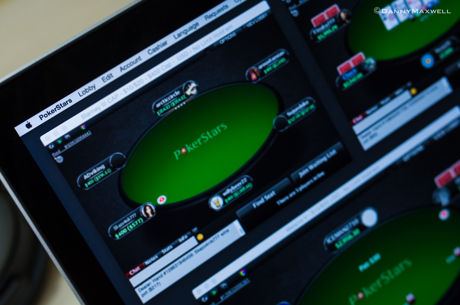Bryan Paris Reviews My Deep Run in the PokerStars Sunday Million, Part 1

Lately I have found less and less time in my schedule to play online poker tournaments, usually delegating myself to playing a few on Sundays, mostly under the screen name “WacKyJaxon” on PokerStars, when I can set aside a block of time. Last month, I decided to play the PokerStars Sunday Million (on March 13) for the first time all year due to it beginning an hour earlier in Europe thanks to Daylight Savings Time having kicked in over in one part of the world and not another.
The tournament began slowly for me as I was quickly down during the early levels, slipping to about half the starting stack before making a good run to climb back to the middle of the pack. Then as the money bubble was approaching, I was in the top 20% of the remaining players and starting to think about how to make a deep run.
I was still near the top of the field with 100 players remaining, and at one point was even in second place with 50 players left. Unfortunately, this is where the good run ended as I eventually bowed out in 26th place to collect a respectable $2,686. However, when your eye is on the top prize of $177,230 — won that week by none other than Mustapha “lasagnaaammm” Kanit — exiting far from the final table seemed disappointing after making it as far as I did.
With that in mind, I got in touch with friend and poker coach Bryan “bparis” Paris and asked him if he wouldn’t mind looking over some of the key hands I had played deep in the tournament. I was curious to see where I played well, where I got lucky, and where I should have played differently.
Paris is a great person to go to for such advice. He is known as one of the most successful tournament players in online poker history, having notched over $9 million in cashes as tracked by PocketFives. This puts him in second place on the online tournament career cashes list only behind the poker legend Chris “Moorman1” Moorman.
I asked Paris to take a look at five key hands I played. Today we’ll look at the first couple, and tomorrow continue with his analysis of the other three from my quest to take down the Sunday Million.
Hand 1: Passive Play with Ace-Queen
With blinds at 750/1,500 and a 150 ante I was dealt A♥Q♣ on the button. An opponent raised to 3,195 from the hijack seat, I opted to flat-call, and the blinds stepped aside. We both were fairly deep-stacked with about 47-50 big blinds each.
After whiffing the flop of 5♦2♠10♠, I called a continuation bet of 4,695. I called another bet, this time for 8,851, when the A♦ on the turn gave me top pair. When the board completed with the 2♥, I opted to call a third bet of 13,838, at which point my opponent showed he had three-barrel bluffed with Q♦9♠.
Paris: This hand is a nice illustration of how you can maximize value against an opponent who is playing too many hands and being too aggressive with them postflop.
At first glance this looks like an attractive spot to three-bet so that we can isolate the preflop raiser’s range — which is weaker than AxQx — in a heads-up pot where we have position. However, this opponent was playing 25% of his hands overall at a full ring table, which means his range for open-raising from the hijack is likely even more than 25% of hands. When our opponent’s range is this weak, we would prefer to be attacking him with hands weaker than this trying to get him to fold (such as AxXx-suited), while this hand is strong enough to turn into a trap.
The postflop play follows naturally from the preflop logic. Even an opponent this loose won’t frequently have a 5x or a 2x in hand, meaning we’re only behind against a 10x or a pocket pair. Since we’ve established our opponent is likely playing over 25% of hands, we have an easy call on the flop with our second-nut ace-high. It would be ideal if one of our cards was a spade so that we had more turns we could keep calling comfortably on, but the hand is still plenty strong against an opponent who is too loose.
The turn is basically perfect, as it’s a card our opponent will continue to bluff on a lot which also makes it overwhelmingly likely that we have the best hand. I don’t really see much merit in raising either the turn or the river, and we wound up getting plenty of value here from his Qx9x-offsuit — which, by the way, is certainly too loose for him to be raising from this spot pre, confirming our read of him playing too many hands.
Lesson: Sometimes your strongest hands play better as calls if your opponent is playing too many hands and making expensive mistakes postflop.
Hand 2: Jamming a Short Stack with Ace-Eight
Much deeper in the tournament with blinds at 20,000/40,000 and a 4,000 ante, I found myself down to just 14 big blinds and was looking for spots to jam my stack and hopefully pick up some needed chips (and hopefully also to have showdown value if called).
In this hand a player who hadn’t been getting out of line too often raised the action to 86,000 from mid-position, and another player flat-called behind him. I then jammed my stack of 560,324 all in with A♦8♠ and thought I was out of the tournament when the original raiser called me and turned over A♠A♣. Lady luck, however, was on my side as the board ran out J♦6♣8♦2♣8♥ awarding me with a huge pot.
Paris: In this hand we come to a common spot in this type of tournament, one where we have less than 20 big blinds and are looking to re-jam our stack. This spot appears attractive enough on the surface, with almost seven big blinds in the pot already and our having an ace. However, the problem with this hand is that it performs very poorly against your opponent’s likely calling ranges.
If we give them each a calling range of 77+, ATs+, AJo+, and KQs, we only have 29% equity when called. By comparison (and somewhat counter-intuitively), if we replace our Ax8x-offsuit with 10x9x-suited, we now have 35% against the same range. We pick up seven BBs the times we win the pot with no showdown, and the times we get called by one player we have x-percent equity in a 32.5 big blind pot, meaning we’d have 9.1 big blinds of equity (28% of 32.5) with Ax8x-offsuit for a loss of five big blinds.
This means we’d need to get both players to fold five times for every seven times they call, or 41.6% of the time, which I think is too optimistic here. (Note that I have omitted the math for when both players call, as that will happen quite infrequently, but suffice it to say those times are even worse for you.)
If we replace our Ax8x-offsuit with 10x9x-suited, we now have 11.4 big blinds of equity (35% of 32.5 BBs) the times we get called, meaning we only lose 2.8 big blinds when called vs. a 7 BB win when they fold. Now we only need three folds for every seven calls for us to break even (so 30% of the time both fold), which seems a bit more realistic.
I still think 10x9x-suited is probably too wide here — I think I would go with something like ATs+, AJo+, KJs+, 55+, and if you wanted to expand that range you would first add in the other suited Broadway hands and all of the suited aces before getting anywhere near Ax8x-offsuit.
As far as the results, must be nice — but this is the type of thing that you have to do sometimes if you want to make a run in a huge field tournament like the Sunday Million.
Lesson: When establishing your re-jam range, it’s not enough to just consider your hand’s raw strength, but how it performs when called.
We continue tomorrow with more analysis from Paris — and more lessons — from my Sunday Million run, including one hand in which I overplay ace-nine from the button, another in which I call a three-bet preflop with pocket sevens, and a third featuring me trying a three-barrel bluff with king-queen suited.
You can get coaching from Bryan Paris at bryanjamesparis.com and follow him on Twitter at @bparispoker.
You can also follow this author on Twitter at @JaxonPoker.
Want to stay atop all the latest in the poker world? If so, make sure to get PokerNews updates on your social media outlets. Follow us on Twitter and find us on both Facebook and Google+!









